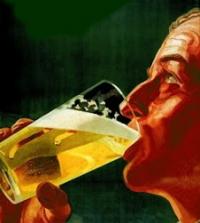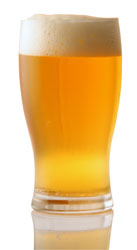Are you saying hopstand as in a "steep" or throwing hops into the chilling wort or what? I used to get to flameout, throw hops into the kettle, put the lid on and walk away for 15-20 minutes and then chill. I called it a "steep" because the heat was off. How are you defining a hopstand?Two batches (1 beer and 1 cider) are in the primary.
The beer (IPA) used my "standard" IPA grist, and I used some Herkules for bittering, a half oz each of Columbus and Cent as FWH, 1 oz Columbus at 10 min left, 1 oz Cent w/ 5 min left, and 0.5 oz of both Columbus and Cent for a 20-min hopstand. A fresh pack of US-05 is handling the heavy lifting in the primary.
I don't use hopstands much anymore, but I needed that time to get the cider thrown together, and the basement smelled nice, so hopefully some of that will carry over to the final product.
Not a bad brewday.

Anyone brewing this week?
#101

Posted 09 August 2017 - 06:38 PM
#102

Posted 09 August 2017 - 06:44 PM
Here's what I do for a hopstand: After I cut the heat, I cover the kettle, Armstrong it down to the basement, and run some tap water through it, and I collect some of that super-hot water to make up some Star-San solution.
I figure this drops the temp down a bit (not quite sure how far, but it's below boiling, and I guess probably below 200°F).
Then, I chuck the HS hops into the kettle, cover, and set the timer, usually for anywhere from 15-30 min, and time's up, chill as normal.
My kettle is an el-cheapo turkey fryer Al pot that doesn't have a thermometer, so there's a little guesswork involved with doing hopstands this way.
A bit crude/old school, sure, but it seems to work so far.
#103

Posted 09 August 2017 - 07:01 PM
#104

Posted 09 August 2017 - 07:11 PM
No I think that sounds totally reasonable. I have a very vanilla 10-gallon Polarware SS kettle and it's only "option" is a lid. I use an El-Cheapo thermo that can be clipped to the side of the pot to monitor the temp which only has to be in the zip code anyway. If I "whirlpool", I start the chill, get the temp around 175°, add the hops and either continue to chill or stop the chill for 15-20 minutes and then pick it back up again. if I do a "steep", I just turn off the heat, add an ounce or two of hops, put the lid on and walk away for 20-30 minutes. The temp will drop during that time and then I'll start the chill. I feel like I get a nice late-hop character this way but I haven't done it in awhile.
Your approach sounds reasonable, too, and probably better than mine, in that you can better dial in the temp before adding in the HS hops, whereas I tend to wing it a bit.
I do have a long-stemmed Thermoworks thermo that usually lives in the garage b/w brewdays; might have to press that into service later in the brewday (it's usually done and put away before the wort gets to a boil).
#105

Posted 09 August 2017 - 07:18 PM
I feel like there has been some discovery in terms of hops and the temps associated with them. Hops added during the boil, dry hops, whirlpool hops at 175°, FWH which might be at 150° or whatever. Maybe it's about preserving oils or something, not sure but it occurs to me that you could add hops anywhere between 100° and 180° and benefit from it. I find that part of the process fascinating because in the old days it seemed like there were bittering additions, flavor additions and aroma additions and that's it. We have come a long way.Your approach sounds reasonable, too, and probably better than mine, in that you can better dial in the temp before adding in the HS hops, whereas I tend to wing it a bit.
I do have a long-stemmed Thermoworks thermo that usually lives in the garage b/w brewdays; might have to press that into service later in the brewday (it's usually done and put away before the wort gets to a boil).
#106

Posted 10 August 2017 - 04:41 AM
I feel like there has been some discovery in terms of hops and the temps associated with them. Hops added during the boil, dry hops, whirlpool hops at 175°, FWH which might be at 150° or whatever. Maybe it's about preserving oils or something, not sure but it occurs to me that you could add hops anywhere between 100° and 180° and benefit from it. I find that part of the process fascinating because in the old days it seemed like there were bittering additions, flavor additions and aroma additions and that's it. We have come a long way.
Soon you will start adding your dry hops on day one and a second dose on day 3, things that were never even thought of in the past.
#107

Posted 10 August 2017 - 05:40 AM
Agreed. I fully expect more brewing myths to fall and more tricks and tips to come to light about how to do any number of things... mash, runoff, boil, add hops, get yeast started and a hundred other things. I've mentioned numerous times that we have so much access to information and high-quality ingredients that we can make just about anything we want and make it well. For anyone who started homebrewing in the 1970s and then quit only to come back now, I think they would be blown away by all of it.Soon you will start adding your dry hops on day one and a second dose on day 3, things that were never even thought of in the past.
#108

Posted 10 August 2017 - 08:23 AM
Here's what I do for a hopstand: After I cut the heat, I cover the kettle, Armstrong it down to the basement, and run some tap water through it, and I collect some of that super-hot water to make up some Star-San solution.
I figure this drops the temp down a bit (not quite sure how far, but it's below boiling, and I guess probably below 200°F).
Then, I chuck the HS hops into the kettle, cover, and set the timer, usually for anywhere from 15-30 min, and time's up, chill as normal.
My kettle is an el-cheapo turkey fryer Al pot that doesn't have a thermometer, so there's a little guesswork involved with doing hopstands this way.
A bit crude/old school, sure, but it seems to work so far.
I believe you'd be better off to use that hot water for cleaning and to use cold water for making starsan. this is if I'm remembering what the manufacturer said about this correctly.
#109

Posted 10 August 2017 - 08:31 AM
#110

Posted 10 August 2017 - 09:38 AM
I believe you'd be better off to use that hot water for cleaning and to use cold water for making starsan. this is if I'm remembering what the manufacturer said about this correctly.
I do use cold water for Starsan.
Good points. My searches on teh intertubez to answer this question have shown competing opinions (some say hot water, some say cold water).
I've got a call in to Five Star Chemicals, and I'm supposed to get a return call from one of their lead chemists to answer this question.
Will update when I get a callback.
#111

Posted 10 August 2017 - 09:50 AM
Good points. My searches on teh intertubez to answer this question have shown competing opinions (some say hot water, some say cold water).
I've got a call in to Five Star Chemicals, and I'm supposed to get a return call from one of their lead chemists to answer this question.
Will update when I get a callback.
Ok, news from the front: Just got off the phone with one of Five Star's lead chemists.
Her answer: as long as the water use to make a StarSan solution isn't boiling (since that could volatize the phosphoric acid that makes StarSan work and pose a respiratory hazard), there is no detriment to using hot vs. cold water.
She said both hot and cold water work equally well, but the hotter water can shorten the amount of time needed for sanitizing, but in the end, to use whatever water temp you're comfortable with, just as long as the water is below 212°F.
Makes me feel better. ![]()
#112

Posted 10 August 2017 - 09:52 AM
#113

Posted 11 August 2017 - 06:02 AM
#114

Posted 11 August 2017 - 06:08 AM
Would like to brew tonight. Threw together and IPA recipe with 16oz of hops just for Ken, 12.5 oz after the boil ![]() . After this I really need to start getting some fall beers going: Smokey Brown, Amber, Dunkel, Fest etc.
. After this I really need to start getting some fall beers going: Smokey Brown, Amber, Dunkel, Fest etc.
#115

Posted 11 August 2017 - 06:29 AM
After this I really need to start getting some fall beers going: Smokey Brown, Amber, Dunkel, Fest etc.
Same here. Back in March-ish, I bought some roasted barley, choc malt, and flaked barley for a few porters and stouts, but the weather got warm before I could make them.
So, they've been sitting, vacuum-sealed, since, and I think the time is near to bust those out and get some darkness in the pipeline for falltime.
#116

Posted 11 August 2017 - 07:44 PM
Edited by ncbeerbrewer, 11 August 2017 - 07:44 PM.
#117

Posted 18 August 2017 - 08:31 AM
Nothing this week, but next week, a clone batch of Nosferatu imperial red ale is on deck.
Some of my homegrown Cascades are scheduled to make an appearance.
#118

Posted 18 August 2017 - 11:57 AM
maybe, I'll have fresh 2124 from the lager I'm kegging
#119

Posted 21 August 2017 - 08:05 PM
#120

Posted 26 August 2017 - 07:56 AM
1 user(s) are reading this topic
0 members, 1 guests, 0 anonymous users











